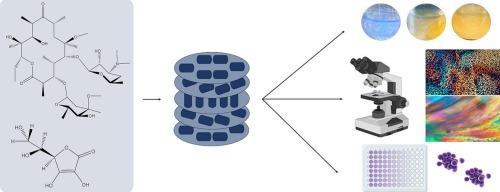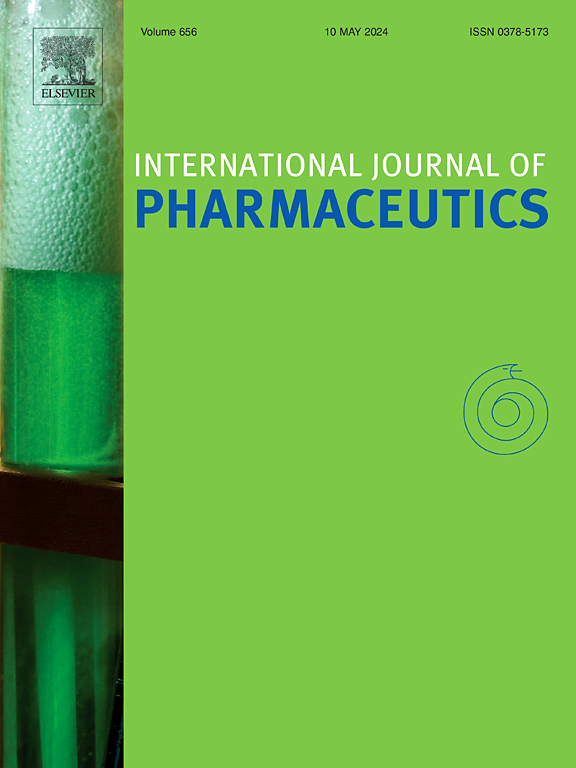克拉霉素-抗坏血酸的无载体胆固醇液晶和干凝胶具有增强的抗菌和抗生物膜活性
IF 5.2
2区 医学
Q1 PHARMACOLOGY & PHARMACY
引用次数: 0
摘要
抗菌素耐药性是一个全球性问题,需要制定创新的药物战略。本研究建立了两种由克拉霉素(CTY)和抗坏血酸(AA)组成的无载体超分子体系:半固态两性甾体液晶(CLC)和干凝胶。CLC凝胶首次报道了在没有额外结构剂的情况下,由抗生素自发和稳定地形成胆固醇相。流变学研究和偏振光显微镜(PLM)研究表明,中间相表现出典型的粘弹性行为,具有溶致性和热致性特征,由均匀的纳米颗粒组成,动态光散射(DLS)证实了这一点。该体系增强了CTY的抑菌活性。这反映在较低的最低抑制浓度(MIC)和对金黄色葡萄球菌生物膜的抑制,包括临床分离株。这些发现突出了其在局部或口服抗生素制剂中的潜在应用。通过x射线衍射图计算面间距离,并通过扫描电子显微镜(SEM)进一步证实了该干凝胶的层状结构。该系统为抗生素处方提供了一个新颖、简单的平台。本文章由计算机程序翻译,如有差异,请以英文原文为准。

Carrier-free cholesteric liquid crystal and xerogel of clarithromycin-ascorbic acid with enhanced antimicrobial and antibiofilm activity
Antimicrobial resistance represents a worldwide problem that necessitates the creation of innovative pharmaceutical strategies. In this study, two carrier-free supramolecular systems composed exclusively of clarithromycin (CTY) and ascorbic acid (AA) were developed and characterized: a semi-solid amphotropic cholesteric liquid crystal (CLC) and a xerogel. The CLC gel represents the first report of a spontaneous and stable formation of a cholesteric phase from an antibiotic without additional structuring agents. Rheological studies and polarized light microscopy (PLM) show that the mesophase displayed typical viscoelastic behavior with both lyotropic and thermotropic features and consisted of nanometric particles with moderate uniformity, as confirmed by dynamic light scattering (DLS). The system enhanced the antibacterial activity of CTY. This was reflected in a lower minimum inhibitory concentration (MIC) and in the inhibition of Staphylococcus aureus biofilms, including clinical isolates. These findings highlight its potential use in topical or oral antibiotic formulations. The xerogel showed a lamellar organization, as revealed by the calculation of interplanar distances from the X-ray diffraction pattern and further supported by scanning electron microscopy (SEM). This system offers a novel and simple platform for the formulation of antibiotics.
求助全文
通过发布文献求助,成功后即可免费获取论文全文。
去求助
来源期刊
CiteScore
10.70
自引率
8.60%
发文量
951
审稿时长
72 days
期刊介绍:
The International Journal of Pharmaceutics is the third most cited journal in the "Pharmacy & Pharmacology" category out of 366 journals, being the true home for pharmaceutical scientists concerned with the physical, chemical and biological properties of devices and delivery systems for drugs, vaccines and biologicals, including their design, manufacture and evaluation. This includes evaluation of the properties of drugs, excipients such as surfactants and polymers and novel materials. The journal has special sections on pharmaceutical nanotechnology and personalized medicines, and publishes research papers, reviews, commentaries and letters to the editor as well as special issues.

 求助内容:
求助内容: 应助结果提醒方式:
应助结果提醒方式:


